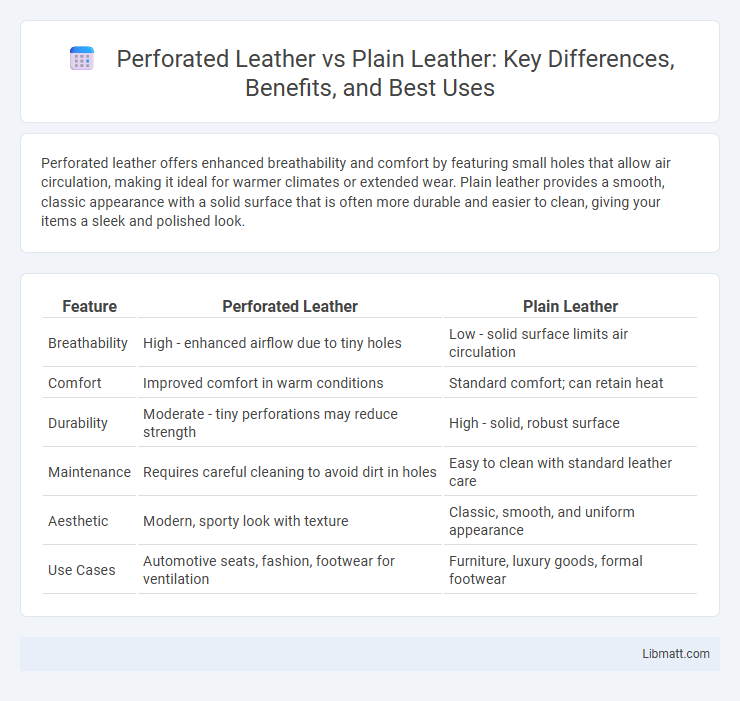Perforated leather offers enhanced breathability and comfort by featuring small holes that allow air circulation, making it ideal for warmer climates or extended wear. Plain leather provides a smooth, classic appearance with a solid surface that is often more durable and easier to clean, giving your items a sleek and polished look.
Table of Comparison
| Feature | Perforated Leather | Plain Leather |
|---|---|---|
| Breathability | High - enhanced airflow due to tiny holes | Low - solid surface limits air circulation |
| Comfort | Improved comfort in warm conditions | Standard comfort; can retain heat |
| Durability | Moderate - tiny perforations may reduce strength | High - solid, robust surface |
| Maintenance | Requires careful cleaning to avoid dirt in holes | Easy to clean with standard leather care |
| Aesthetic | Modern, sporty look with texture | Classic, smooth, and uniform appearance |
| Use Cases | Automotive seats, fashion, footwear for ventilation | Furniture, luxury goods, formal footwear |
Introduction to Perforated and Plain Leather
Perforated leather features tiny, strategically placed holes enhancing breathability and comfort, making it ideal for automotive seats and fashion items in warm climates. Plain leather, known for its smooth, solid surface, offers durability and a classic aesthetic suitable for furniture, footwear, and accessories. Both types leverage the natural strength of cowhide or lambskin but serve different functional and stylistic purposes based on perforation presence.
What is Perforated Leather?
Perforated leather features tiny holes punched into its surface, enhancing breathability and comfort by improving air circulation. This type of leather is commonly used in automotive seats, footwear, and apparel to reduce heat buildup and moisture accumulation. Compared to plain leather, perforated leather offers better ventilation while maintaining durability and aesthetic appeal.
What is Plain Leather?
Plain leather is a smooth, unpunched material made from animal hides, commonly used in upholstery, fashion, and accessories for its durability and classic appearance. It retains the natural texture and grain of the hide without any perforations or patterns, providing a solid surface that is resistant to wear and easy to clean. Plain leather offers a timeless aesthetic and versatility, making it ideal for both practical applications and elegant design.
Key Differences between Perforated and Plain Leather
Perforated leather features small holes punched throughout the material to enhance breathability, making it ideal for warmer climates or active use, while plain leather offers a smooth, solid surface known for durability and traditional aesthetics. The key difference lies in ventilation and texture; perforated leather improves air circulation and comfort, reducing sweat and heat buildup, whereas plain leather provides a more uniform appearance and is easier to clean. Understanding these differences helps you choose the right leather type based on your needs for ventilation, maintenance, and style.
Breathability and Comfort Comparison
Perforated leather offers superior breathability compared to plain leather due to its tiny holes that allow better air circulation, reducing heat and moisture buildup. This enhanced ventilation keeps your skin cooler and drier, increasing overall comfort, especially in warm climates or during extended wear. While plain leather provides durability and a sleek look, its limited airflow can cause your skin to feel hotter and sweatier over time.
Durability and Maintenance Factors
Perforated leather offers enhanced breathability but can be less durable than plain leather due to the small holes that may weaken the material over time. Plain leather typically provides greater resistance to wear and easier maintenance, as it lacks perforations that can trap dirt and moisture. Regular conditioning and prompt cleaning are essential for both types to preserve their longevity, with plain leather generally requiring less frequent care.
Aesthetic Appeal and Style Choices
Perforated leather offers a dynamic, breathable texture that enhances both comfort and sporty aesthetics, making it a popular choice for automotive interiors and fashion accessories where style meets function. Plain leather showcases a smooth, consistent surface that exudes timeless elegance and versatility, suitable for classic and formal looks. Your selection between these two leathers should align with your desired aesthetic appeal--opt for perforated leather to introduce texture and ventilation, or choose plain leather for a sleek, polished finish.
Common Applications for Each Type
Perforated leather is commonly used in automotive interiors, sports footwear, and high-end fashion apparel due to its breathability and enhanced comfort. Plain leather is favored for classic furniture, luxury handbags, and formal shoes, offering durability and a sleek, polished appearance. Both types meet specific functional and aesthetic needs based on application requirements.
Cost Considerations: Perforated vs Plain
Perforated leather often comes at a higher cost compared to plain leather due to the additional manufacturing processes such as precision cutting and quality control required to create consistent perforations. The enhanced breathability and aesthetic appeal of perforated leather can justify the premium, especially in high-end automotive or fashion applications. When choosing your material, consider the balance between budget constraints and the benefits of improved ventilation and style that perforated leather provides over plain leather.
Choosing the Right Leather for Your Needs
Perforated leather offers enhanced breathability and comfort, making it ideal for hot climates or active lifestyles, while plain leather provides superior durability and a classic appearance suited for formal settings. Selecting the right leather depends on whether ventilation and moisture management or long-lasting wear and traditional style are your primary priorities. Understanding these functional differences helps ensure your leather choice aligns perfectly with your usage and environment.
Perforated leather vs plain leather Infographic

 libmatt.com
libmatt.com